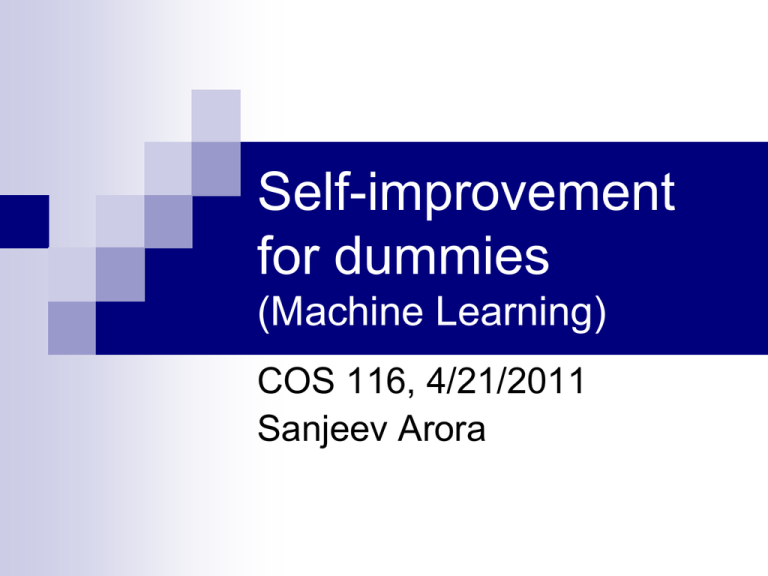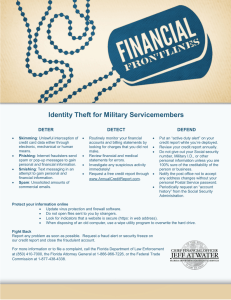Self-improvement for dummies (Machine Learning) COS 116, 4/21/2011
advertisement

Self-improvement
for dummies
(Machine Learning)
COS 116, 4/21/2011
Sanjeev Arora
Artificial Intelligence
Definition of AI (Merriam-Webster):
Next1.
time:
2.
Today:
The capability of a machine to imitate intelligent human
behavior
Branch of computer science dealing with the simulation of
intelligent behavior in computers
Definition of Learning:
To gain knowledge or understanding of or skill in by study,
instruction, or experience
Today’s lecture: Machine Learning
Machine learning =
“Programming by example”
Show the computer what to do,
without explaining how to do it.
The computer programs itself!
In fact, continuous improvement
via more data/experience.
Recall your final Scribbler lab
Task: Program Scribbler to navigate a maze.
Avoid
walls, avoid “lava”,
head towards the goal.
As maze becomes more complex,
programming becomes much harder. (Why?)
Program Scribbler
Teach Scribbler
to
Program
to
navigate aa maze
maze
navigate
Start with a simple program:
1. Run the maze.
2. Label this trial GOOD or BAD, depending on
whether goal was reached.
3. Submit data from the trial to a “learning
algorithm”, which uses it to devise a better
program.
4. Repeat as needed.
Is this how you learned to drive a car?
Note: imitating nature may not be best
Examples:
Birds
vs
Cheetahs
Airplanes
Race cars
vs
Machine’s “experience” of the world
n sensors, each produces a number:
“experience” = an array of n numbers
Example: video camera: 480 x 640 pixels
n = 480 640 = 307200
In practice, reduce n via some processing
Example: Representing
wood samples
Brownness scale
1
…
light
Texture scale
1
smooth
10
dark
…
10
rough
(3, 7) = wood that is fairly light brown but
kind of on the rough side
A learning task and its
mathematical formulation
Given: 100 samples of oak, maple
Figure out labeling
(“clustering”)
Given a new sample,
classify it as oak, maple…
Redwood
oak
texture
maple
New point
color
Fact: producing “best” clustering
is NP-complete
“Clustering”
3-means algorithm (produces 3
clusters)
Some notions:
Mean of k points (x1, y1), (x2, y2), ... , (xk, yk)
is
x1 x 2 ... xk y1 y 2 ... yk
,
k
k
(“center of gravity”)
Distance between points (x1, y1), (x2, y2) is
( (x1 – x2)2 + (y1 – y2)2 )½
3-means Algorithm (cont.)
Start by randomly picking 3 data points as your “means”
Repeat many times:
{
Assign each point to the cluster whose mean is closest to it
Compute means of the clusters
}
http://en.wikipedia.org/wiki/K-means_clustering
What about learning a more
complicated object?
Speech?
Motion?
Handwriting?
Similar data
representations,
but more
“dimensions”
One major idea: modeling
uncertainty using probabilities
Example: Did I just hear
“Ice cream” or “I scream”?
Assign probability ½ to each
Listen for subsequent phoneme
_?_ “is”: use knowledge of usage patterns…
Increase probability of “Ice cream” to 0.9
Spam filtering
How would you define Spam to a computer?
Descriptive approach:
“Any email in ALL CAPS, unless it’s from my kid
brother, or that contains the word ‘mortgage’, unless
it’s from my real estate agent, …”
Difficult to come up with an good description!
Learning approach:
“Train” the computer with labeled examples of spam
and non-spam (a.k.a. ham) email.
Easy to find examples of spam – you probably get
hundreds a day!
Spam Filtering
Given: A spam corpus and ham corpus.
Goal: Determine whether a new email is spam or ham.
Step 1: Assign a “spam score” to each word:
Fspam(word) = Fraction of emails in spam corpus that contain word.
Fham(word) = Fraction of emails in ham corpus that contain word.
SpamScore( word )
Fspam word
Fham word
Observe:
SpamScore(word) > 1 if word is more prevalent in spam.
SpamScore(word) < 1 if word is more prevalent in ham.
Spam Filtering
Step 2: Assign a “spam score” to the email:
SpamScore(email) = SpamScore(word1) x … x SpamScore(wordn),
where wordi is the ith word in email.
Observe:
SpamScore(email) >> 1 if email contains many spammy words.
SpamScore(email) << 1 if email contains many hammy words.
Step 3: Declare email to be spam if SpamScore(email) is high
Spam Filtering
Advantages of this type of spam filter:
Though
simple, catches 90+% of spam!
No explicit definition of spam required.
Customized for your email.
Adaptive – as spam changes, so does filter
Dominant ML paradigm today
Learn a probabilistic “model” (i.e. succinct description of data)
Bayes net model for
identifying low-risk
customers for
automobile insurance
(arrows denote “dependent
random variables”)
Preview of lab: Text synthesis
(simplistic version)
Idea: Use example text to generate similar text.
Input: 2007 State of the Union Address.
Output: “This war is more competitive by strengthening math and
science skills. The lives of our nation was attacked, I ask you to
make the same standards, and a prompt up-or-down vote on the
work we've done and reduce gasoline usage in the NBA.”
Text synthesis
How it works: Output one word at a time.
1.
2.
3.
4.
Let (v, w) be the last two words outputted.
Find all occurrences of (v, w) in the input text.
Of the words following the occurrences of (v, w),
output one at random.
Repeat.
Variants: Last k words instead of last 2 words.
Handwriting recognition
[LeCun et al, AT&T, 1998]
The LeNet-5 system
Trained
on a database:
60,000 handwritten digits
Reads ~10% of all checks cashed in the US;
can tolerate weird handwriting, errors etc.
Aside: How to get large amounts of data?
(major problem in ML)
• Answer 1: Use existing corpuses (lexis-nexis, WWW for text)
• Answer 2: Create new corpuses by enlisting people
in fun activities. (Recall Image-Labeling Game in Lab 1)
Example: SAT Analogies
Bird : Feathers :: Fish : ____
Idea: Search web to learn relationships between words.
[Turney 2004]
Example: Is the answer above “water” or “scales”?
Most common phrases on the web:
“bird has feathers”, “bird in air”, “fish has scales”, “fish in water”.
Conclusion:
Right answer is “scales”.
SAT Analogies [Turney 2004]
On a set of 374 multiple-choice SAT analogies,
this approach got 56% correct.
High-school seniors on the same set:
57%
(!)
Mark of “Scholastic Aptitude”?
Image labeling [Blei et al, 2003]
Princeton prof!
Another
solution:
Learn captions from examples.
System
trained on a Corel database
6,000 images with captions.
Applied
to images without captions.
Helicopter flight [Abbeel et al 2005]
Idea: Algorithm learns to pilot a helicopter
by observing a human pilot.
Results: Even better than the human pilot.
Next time: Artificial Intelligence
What do we mean by it? Turing’s test for intelligence.
To do before then:
(a)Complete assigned readings.
(b) Participate in a Turing test on Turinghub.com.
Cut and paste the entire conversation into a document
and bring to class to hand in (and pass around).
(c)Write a para on how convincing you find Searle’s
objection.



